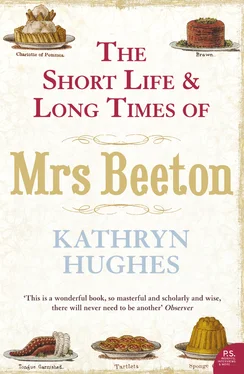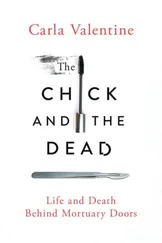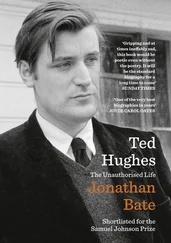Soon Isabella’s nannying duties were expanded even further. As the clutch of children increased, it soon became clear that Ormond House could not hold the growing Dorling brood. The noise alone was unbearable: one day Henry Dorling, disturbed by the din, stuck his head around his study door and demanded to know what was going on. ‘That, Henry,’ Elizabeth is reported to have said, ‘is your children and my children fighting our children.’ The solution, though, was close at hand. The Grandstand was not needed for all but a few days a year. It would provide the perfect place to store extra children, those who were old enough to leave their mother but not yet sufficiently independent to be sent away to school. In this satellite nursery, housed in a building that resembled a stranded ocean liner on a sea of green, the little Dorlings would be watched over by Granny Jerrom and sensible, grown-up Isabella.
The fact that Isabella Beeton spent part of her youth in the Epsom Grandstand has insinuated itself into her mythology, until the idea has become quite fixed that she spent years at a time up there, running a kind of spooky orphanage. This, as commentators have been quick to point out, could not be in greater contrast to the cosy intimate atmosphere that Mrs Beeton urges her readers to create for their own families: ‘It ought, therefore, to enter into the domestic policy of every parent, to make her children feel that home is the happiest place in the world; that to imbue them with this delicious home-feeling is one of the choicest gifts a parent can bestow.’ What has been missed, though, in the rush to point out the discrepancy between Mrs Beeton’s advice and her personal experience, is the fact that in the first half of the nineteenth century it was entirely usual for tradesmen to shunt their families round in this way. Grocers, drapers, and chemists all used their premises flexibly, sometimes raising an entire family over the shop, and at others sending some of the children to live in other buildings associated with the business. The Dorlings’ decision to use the Grandstand as an annexe to Ormond House may seem odd to us now, but to their Epsom neighbours it was simply the way things were done. No more peculiar than the fact that the now elderly William Dorling had moved out of Ormond House and gone to live with his daughter at the post office in the High Street. People were more portable than buildings.
The second point about Isabella’s creepy kingdom on top of the hill is that there is no way of telling how often and for how long she was up on the Downs. For at least two years of her teens she was away at boarding school, first in London and then Heidelberg, and so unavailable for Grandstand duties. Once she returned home for good, probably in 1854, her letters make clear that, far from being marooned for weeks at a time, she moved constantly between Ormond House and the Downs. For instance, in a letter that she writes to her fiancé Sam Beeton in February 1856 she explains that she and her stepsister Jane have just got back from the Grandstand where they ‘have been doing the charitable to Granny. Poor old lady, she complained sadly it was so dull in the evening sitting all alone, so we posted up there to gossip with her.’ Another time she mentions that she has been up at the Grandstand all day ‘and of course have not sat down all day’, yet makes it clear that she is now writing from the relative calm of Ormond House. When the Grandstand was needed for a race meeting, it was Isabella who was responsible for ‘transporting that living cargo of children’ to alternative accommodation, usually a house at 72 Marine Parade in Brighton, close to the racecourse where Dorling also held the position of clerk. Far from being in permanent exile, Isabella Mayson was a body in a perpetual state of motion.
Still, whether or not Isabella was in attendance at any particular moment, it remains the case that the Grandstand made a strange kindergarten. A huge barn of a building, 50 yards long and 20 yards wide, and designed to hold 5,000 people, it was now home to perhaps no more than six little children and their minders. It has been suggested that the closest analogy would be that of living in a boarding school during the holidays. But there was an important difference. The Grandstand had never been built with children in mind. It was designed for adults and adult activity – betting, drinking, flirting, parading, coming up before the makeshift magistrate. On the one hand the world of the Dorlings and the world of Epsom racecourse were soldered together to the point where one had become a synonym for the other: or, as the Illustrated London News would put it in a few years’ time: ‘What cold punch is to turtle, mustard to roast beef, ice to Cliquot champagne, Chablis to oysters, that is Mr Dorling to the Derby.’ Yet, at the same time, there were occasions when those two worlds, the world of the bourgeois family and that of the seedy racetrack were a very awkward fit. It was this paradox that poor little Alfred Dorling, acquiring his fatal condom from among the ‘racy’ characters who hung around the Downs, had failed to understand.
Certainly we can say that the scale of the place was grand, designed to see and be seen in. As such it was a public theatre, something that older, aristocratic members of the racing fraternity found hard to grasp. The Duchess of Richmond of Goodwood wrote to Dorling about this time grandly informing him: ‘The Duchess of Richmond would prefer a portion of the Grand Stand railed off, if she could have it to Herself .’ But there was little chance of the Duchess, even with her Goodwood credentials, getting her way. The point about the Grandstand was that it belonged to the modern world and, as such, was a democratic space to which anyone could buy the right to enter. There was a huge pillared hall, a 30-yard-long saloon, four refreshment rooms, and a series of committee rooms. In 1840 when Queen Victoria had made her second and final visit to Epsom, £200 had been spent on getting the Grandstand’s wallpaper and carpets up to scratch, with the result that the Dorling children, quite literally, lived in a place that was fit for a queen. Eighteen years later when Prince Albert made a return visit, this time with his future son-in-law the German Crown Prince Frederick, the papers reported that on the receiving room wall was ‘the Royal Coat of Arms, executed in needlepoint by the Misses Dorling’. The nursery, then, was a curiously public and even ceremonial space inside which the children were expected to eat and sleep while leaving as little trace as possible of their small lives. At night they lay on truckle beds that could be folded up during the day. Whenever Henry Dorling needed to show a visiting dignitary around they could be herded into another room. At a moment’s notice all evidence of their existence could be made to disappear.
Particularly intriguing about the Grandstand set-up is the fact that the future Mrs Beeton spent formative stretches of her young life next to a commercial kitchen that catered to thousands at a time. Much has been made of Mrs Beeton’s picnic plans for forty people, or her dinner party menus for eighteen. Perhaps the fact that she lived on a Brobdingnagian scale – the eldest girl in a family of twenty-one and an amateur nursery maid in a space designed for thousands – explains the ease with which she came to think in large numbers. For this reason Dickens’ description of the Grandstand kitchens working at full pelt for the Derby is worth quoting in full.
To furnish the refreshment-saloon, the Grand Stand has in store two thousand four hundred tumblers, one thousand two hundred wineglasses, three thousand plates and dishes, and several of the most elegant vases we have seen out of the Glass Palace, decorated with artificial flowers. An exciting odour of cookery meets us in our descent. Rows of spits are turning rows of joints before blazing walls of fire. Cooks are trussing fowls; confectioners are making jellies; kitchen-maids are plucking pigeons; huge crates of boiled tongues are being garnished on dishes. One hundred and thirty legs of lamb, sixty-five saddles of lamb, and one hundred shoulders of lamb; in short, a whole flock of sixty-five lambs, have to be roasted, and dished and garnished, by the Derby Day. Twenty rounds of beef, four hundred lobsters, one hundred and fifty tongues, twenty fillets of veal, one hundred sirloins of beef, five hundred spring chickens, three hundred and fifty pigeon pies; a countless number of quartern loaves, and an incredible quantity of ham have to be cut up into sandwiches; eight hundred eggs have got to be boiled for the pigeon-pies and salads. The forests of lettuce, the acres of cress, and beds of radishes, which will have to be chopped up; the gallons of ‘dressing’ that will have to be poured out and converted into salads for the insatiable Derby Day, will be best understood by a memorandum from the chief of that department to the chef-de-cuisine , which happened, accidentally, to fall under our notice: ‘Pray don’t forget a large tub and a birch-broom for mixing the salad!’
Читать дальше












